What is Food Photography?
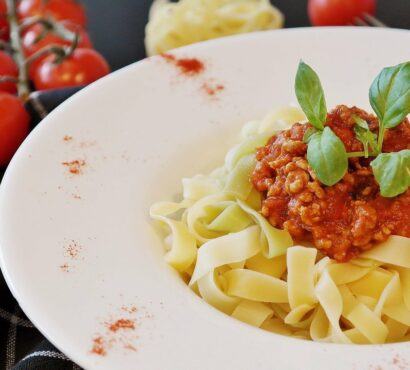
When it comes to food photography – the first images that come to my mind are those from my childhood – whether it be a television commercial during the Saturday Morning Cartoons for my favorite breakfast cereal or perhaps, an image of giant-size Big Mac – with its hot warm beef patties, pickles, onions and tomatoes looking fresh and crisp, on a perfect and puffy sesame seed bun.
But I knew in REALITY, the minute I ever went out to McDonalds, that same hamburger looked NOTHING like what was in the advertisement. But this never really hit me until years later, that these food images have been prepped, propped up, puffed up – the same way a makeup artist and stylist prepares a model before a photoshoot. That’s when everything began to make sense to me.
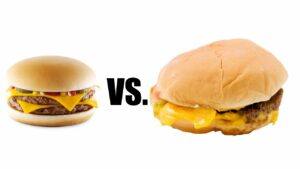
I’m beginning to understand that there’s a lot more to food photography than just throwing a dish together and snapping a quick photo.
What exactly is Food Photography?
Think of it as Still Life Photography for Food. It’s all about the food, where the food is the subject and star of the show. And from what I just described earlier, it’s primary focus has to be to create the most attractive, appealing and artistic display of food.
And what better purpose for all of these attractive food images than commercial photography for magazines, ads, brochures, menus and cook books. Now I’ve taken countless pictures with my cell phone of my dinner numerous time to post on social media – not really as a form of art, but more like – “Hey everyone, I just checked in at the local Wahlburgers to grab a bite to eat:
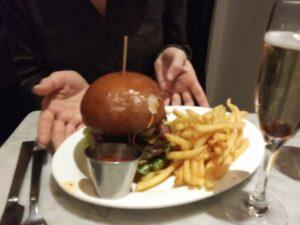
Even though this is a quick pic to take and upload on the spot, I wouldn’t call it a work or art when compared to some of the more professional food photography images, where, with the perfect natural lighting, angle and other adjustments, can create some of the most appealing images for any food connoisseur.
The History of Food Photography
The earliest history of food photography dates back to as early as the 1800 – although it wasn’t necessarily called ‘food photography’. Thanks to the invention of the daguerreotype in 1839, photography William Henry Fox Talbot took one of the earliest food photographs – which is more like ‘still life’ in my opinion – of a basket of peaches and a pineapple.
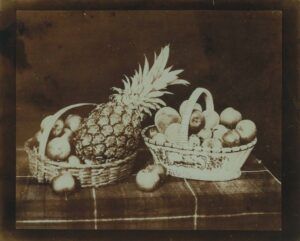
It wasn’t until the 1930’s that brought about the introduction of color in advertisement, which opened up the door further, allowing food photography to not only be seen as merely art, but for commercial use as well. “Cook Booklets” would become popular with the addition of many technicolor photography. In fact, photographers like Nickolas Muray, notably known for his images of Frida Kahlo, would collaborate with women’s magazine McCalls to presenting some of the most vibrant images for their homemaking and food pages.

Thanks to his color carbro process for ads in the 1950’s, these images still remain as vibrant as they did nearly seventy years ago.
While cookbooks continued to evolve and showcase more stylized and appealing images of dishes and appetizers, artists were also finding unique ways to include food in their works, sometimes as normal food photography, and other times, often as subjects.
It’s kind of interesting when you think about it – we’re all used to only seeing food in its natural setting – on the dinner table, counter, wrap, plate, etc. looking down upon it as if we were about to eat it, which we should feel like, in my opinion.
Why limit the boundaries of what could be done with food? I know my mother taught me that I shouldn’t play with my food, but she didn’t say anything about having it pose for a photograph. Artists like Peter Fischli and David Weiss, for example, created their Sausage Series or “Wurstserie” in 1979 where sausages and pickles have come to life – and are about to attend a fashion show.

Today, in the prime of the social media age that we live in, you can find millions of food photography images, from professionals and amateurs, to women sharing their mother’s recipes or everyday normies just posting a pic of the PB&J sandwich. Whatever their motives may be, you have to admit that food photography has become a growing and popular form of photography that has really come into its own. And this is something that I’d like to begin practicing myself as a photographer to add to my portfolio.
Just Aim and Shoot
I would think that when it comes to taking photographs of food that all you need to do is aim and shoot, whether you’re using your cell phone or a DSLR camera. But what I failed to realize is that the food needs to be appealing. After all, it is the hero product. Nobody wants to give me thumbs up on my sloppy looking hamburger, with runny ketchup or mayo oozing out the side of it, beneath a soggy looking piece of lettuce, between two hamburger buns that looked like somebody stepped on them before serving them to me. The food needs to be prepared and set up properly beforehand, similar to the way a model would fix herself up before a photoshoot.
Lighting
First there’s the lighting. Sure – for my facebook check in photo – I suppose the restaurant ambience will do, but natural lighting is always the best lighting. Natural lighting just makes the food look that more appealing and visually more desirable to reach out and eat – if you can imagine yourself doing so.
Just as you need the proper lighting for all other forms of photography, including Still Life and Portraiture, your delicious hero in your Food Photography deserves the same attention to these details.
Angle
This is a subtle one for me, and one thing that I failed to notice until recently. Some food photographs are shown from the perspective of the customer – at about a 45 degree angle – while others are shot overhead. Now I’m not in any position to stand on my chair in a restaurant just to grab that overhead shot – so I take it that these are done in a controlled environment – like at home or someone’s studio, where they’ve set the food up properly.
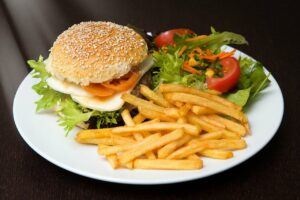
Also – certain foods need to be shot at certain angles. A delicious Spaghetti and meatball dinner could be shot from both angles to capture the thick meatballs, tomato sauce and the details of parmesan, crushed red pepper flakes, oregano, garlic, parsley, etc. An overhead shot may not work well with my hamburger, if I wanted to catch more than just the bun on top, next to the side of lays potato chips and dill pickles.
Conclusion
Food Photography is turning out to be one of the more popular trends lately, in both advertisements and flat lay images that are posted all over Social Media, and a niche that I’m anxious to learn more about.
What are your thoughts on Food Photography? Have you been posting many images all over your Facebook and Instagram pages as well? Let me know!
Thanks!


POST YOUR COMMENTS